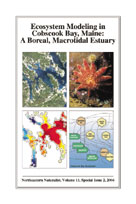In the mid-1990s, an interdisciplinary, multi-institutional team of scientists was assembled to address basic issues concerning biological productivity and the unique co-occurrence of many unusual ecological features in Cobscook Bay, ME. Cobscook Bay is a geologically complex, macrotidal system located on the international border at the mouth of the Bay of Fundy. The strategy adopted by the scientific team was to synthesize the known information on Cobscook Bay, focus new field research on information needs related to basic forcing functions and biological primary productivity, and organize the information in an energy systems model to evaluate the flows of energy and materials through the ecosystem and relate them to the inflows of physical energy using the accounting quantity, emergy. As a consequence of this process, diverse new and existing data have been combined and analyzed, leading to new ways of thinking about the functioning of Cobscook Bay and macrotidal estuaries. The principal finding is that an extraordinary convergence of natural energies creates ideal conditions for supporting the development of ecological organization found in few, if any, other estuarine systems. In this contribution, we review the finding of the component research exercises, discuss their integration into an energy systems model and emergy analysis, and suggest a number of fruitful avenues for future research.
How to translate text using browser tools
1 December 2004
Ecosystem Modeling in Cobscook Bay, Maine: A Summary, Perspective, and Look Forward
Peter Foster Larsen,
Daniel E. Campbell
ACCESS THE FULL ARTICLE

Northeastern Naturalist
Vol. 11 • No. sp2
December 2004
Vol. 11 • No. sp2
December 2004




